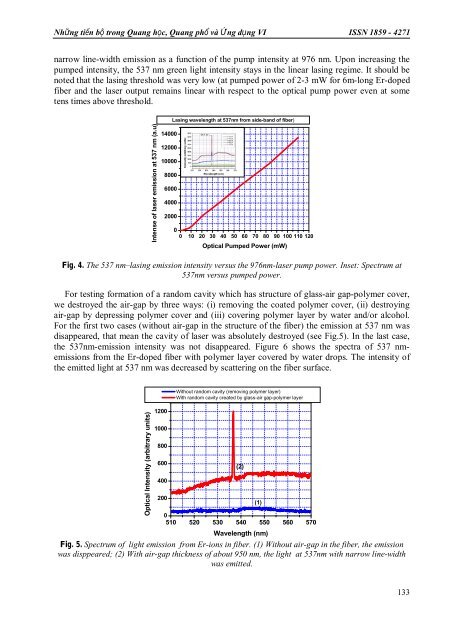Nhng tin b trong Quang hc, Quang ph và ng dng VI ISSN 1859 - 4271
Nhng tin b trong Quang hc, Quang ph và ng dng VI ISSN 1859 - 4271
Nhng tin b trong Quang hc, Quang ph và ng dng VI ISSN 1859 - 4271
You also want an ePaper? Increase the reach of your titles
YUMPU automatically turns print PDFs into web optimized ePapers that Google loves.
Nhữ<strong>ng</strong> tiến bộ <stro<strong>ng</strong>>tro<strong>ng</strong></stro<strong>ng</strong>> <stro<strong>ng</strong>>Qua<strong>ng</strong></stro<strong>ng</strong>> học, <stro<strong>ng</strong>>Qua<strong>ng</strong></stro<strong>ng</strong>> <stro<strong>ng</strong>>ph</stro<strong>ng</strong>>ổ và Ứ<strong>ng</strong> dụ<strong>ng</strong> <strong>VI</strong> <strong>ISSN</strong> <strong>1859</strong> - <strong>4271</strong>narrow line-width emission as a function of the pump intensity at 976 nm. Upon increasi<strong>ng</strong> thepumped intensity, the 537 nm green light intensity stays in the linear lasi<strong>ng</strong> regime. It should benoted that the lasi<strong>ng</strong> threshold was very low (at pumped power of 2-3 mW for 6m-lo<strong>ng</strong> Er-dopedfiber and the laser output remains linear with respect to the optical pump power even at sometens times above threshold.Lasi<strong>ng</strong> wavele<strong>ng</strong>th at 537nm from side-band of fiber)Intense of laser emission at 537 nm (a.u)140001200010000800060004000200000 10 20 30 40 50 60 70 80 90 100 110 120Optical Pumped Power (mW)Fig. 4. The 537 nm–lasi<strong>ng</strong> emission intensity versus the 976nm-laser pump power. Inset: Spectrum at537nm versus pumped power.For tes<s<stro<strong>ng</strong>>tro<strong>ng</strong></stro<strong>ng</strong>>>tin</s<stro<strong>ng</strong>>tro<strong>ng</strong></stro<strong>ng</strong>>>g formation of a random cavity which has structure of glass-air gap-polymer cover,we destroyed the air-gap by three ways: (i) removi<strong>ng</strong> the coated polymer cover, (ii) destroyi<strong>ng</strong>air-gap by depressi<strong>ng</strong> polymer cover and (iii) coveri<strong>ng</strong> polymer layer by water and/or alcohol.For the first two cases (without air-gap in the structure of the fiber) the emission at 537 nm wasdisappeared, that mean the cavity of laser was absolutely destroyed (see Fig.5). In the last case,the 537nm-emission intensity was not disappeared. Figure 6 shows the spectra of 537 nmemissionsfrom the Er-doped fiber with polymer layer covered by water drops. The intensity ofthe emitted light at 537 nm was decreased by scatteri<strong>ng</strong> on the fiber surface.Without random cavity (removi<strong>ng</strong> polymer layer)With random cavity created by glass-air gap-polymer layerOptical Intensity (arbitrary units)120010008006004002000510 520 530 540 550 560 570Wavele<strong>ng</strong>th (nm)Fig. 5. Spectrum of light emission from Er-ions in fiber. (1) Without air-gap in the fiber, the emissionwas disppeared; (2) With air-gap thickness of about 950 nm, the light at 537nm with narrow line-widthwas emitted.(2)(1)133















